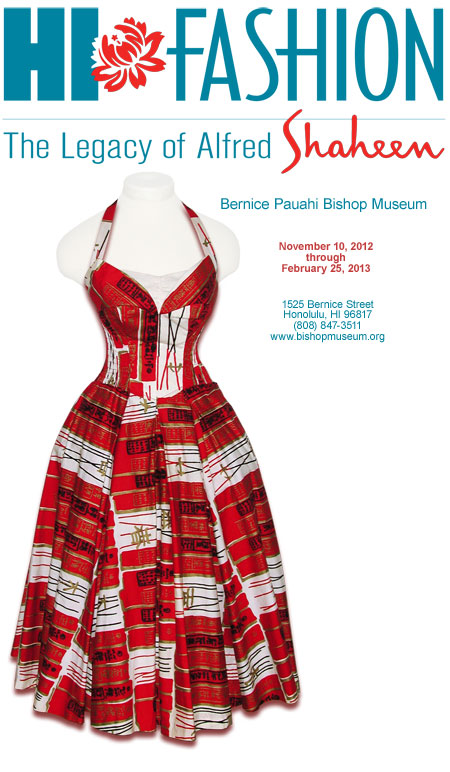ON EXHIBIT: HI Fashion: The Legacy of Alfred Shaheen
 |
| Alfred Shaheen, pioneer of the textile and fashion industry in Hawai‘i, 1955. Photo courtesy of Camille Shaheen. |
A whirl of vibrant colors, lines, images, and patterns. Breathtaking
flair, sunny motifs, and “bombshell” sensations. Splendid aloha styles
of the fifties and sixties. Weave these together with a new approach to
design development and management practice within the Hawaiian garment
industry and what results is the story of Alfred Shaheen, a man whose
impact was more than most will ever recognize.
Bishop Museum celebrates Shaheen’s accomplishments with HI Fashion: The
Legacy of Alfred Shaheen, a special holiday exhibition in the Castle
Memorial Building that will excite and delight museum visitors at
every turn. The exhibition features over two hundred gems of Shaheen
fabric and fashion, on display from November 10, 2012, through February
4, 2013.
HI Fashion is made possible through the very generous and gracious
efforts of Alfred Shaheen’s daughter, Camille Shaheen-Tunberg.
Programming for this exhibition is supported in part by the Honolulu
star-advertiser, Hawai‘i Council for the Humanities and by the Hiroaki,
Elaine & Lawrence Kono Foundation.
Shaheen moved to Hawai‘i from New Jersey with his family in 1938, went
on to earn an engineering degree at Whittier College in California,
then served in the U.S. Army Air Corps during World War II. He returned
to the Islands in 1945 and stepped easily into the family clothing
business. His mother had a custom clothing shop called Margo’s. With
vision and confidence Shaheen established his own shop, Shaheen’s of
Honolulu, in 1948. In a Quonset hut outfitted with equipment that he
designed, Shaheen built his remarkable silk screening business—an
innovative move that led to local production of large quantities of
printed fabric, and with quality control in his hands. Prior to this,
most fabric used for Hawaiian clothing was manufactured on the U.S.
mainland or in Japan.
By 1950, Shaheen put together a business that allowed him to print,
dye, and finish his own brand of fabric and streamlined his production
to the point of producing 60,000 yards of fabric a month. His fabric
was not just of run-of-the mill cloth—Shaheen teamed up with a textile
chemist and others to create metallic paints that glimmered in many of
is textiles. These unique inks were just part of the Shaheen library of
over 1,000 colors and tones.
Shaheen was a proponent of cultural diversity. His team of local
artists and designers reflected a Hawai‘i blend of Japanese, Hawaiian,
Chinese, and other ethnic groups. Those who worked in the House of
Shaheen were encouraged to research, explore, and incorporate cultural
motifs in fabric design. Shaheen sent his designers outside the Islands
on international trips to gather new ideas. These were combined to
create Shaheen’s “fashion fusion” style. Shaheen invested in his
employees’ development, provided good compensation, and valued their
work and ideas. In return, Shaheen employees were highly motivated and
loyal to the business.
By the time Hawai‘i achieved statehood, Shaheen was Hawai‘i’s largest
manufacturer of aloha wear, employed 400 people, and grossed more than
$4 million annually with sales worldwide. His outstanding success
resulted from his “vertical manufacturing”—creating his own designs and
fabrics, turning them into stunning fashions, and distributing these
in his own retail shops and through world-wide wholesaling. This system
allowed for a unique branding and rapid popularization of his high
fashion aloha line.
Shaheen retired in 1988, forty years after starting his business. He
was honored by the State of Hawai‘i with a Lifetime Achievement Award
in 2001. In 2006, the Honolulu Advertiser named him one of the 150 most
influential people, events, and institutions to effect social,
economic, political, and cultural change in Hawai‘i from 1856 onward.
Alfred Shaheen died in 2008 at the age of 86.
The treasures that make up the Bishop Museum exhibition are from the
collection of Camille Shaheen-Tunberg, who has sought out and collected
hundreds of garments produced by her father. In 2010, Shaheen- Tunberg
worked with the San Jose Museum of Quilts and Textiles to create the
first exhibition of Shaheen’s work, titled Hawaii’s Alfred Shaheen:
Fabric to Fashion. Bishop Museum is delighted to share the Shaheen
story through HI Fashion: The Legacy of Alfred Shaheen, a new and
larger exhibition featuring the styles and stories of this great pioneer
of the Hawaiian garment industry.




Wow its a very nice post.Thanks for sharing this wonderful post.
ReplyDeleteBy
Little Mascot
online fashion deals